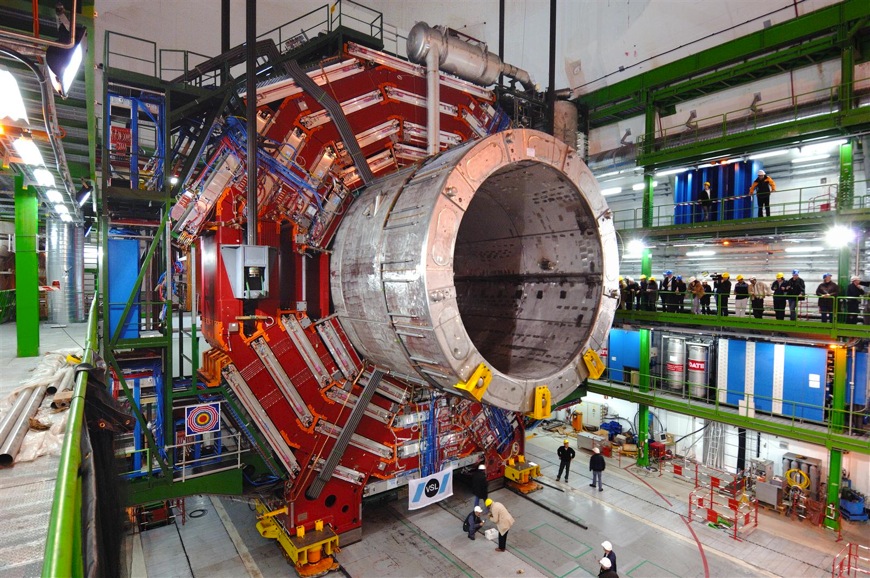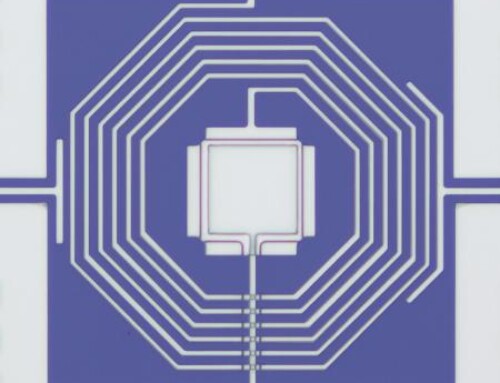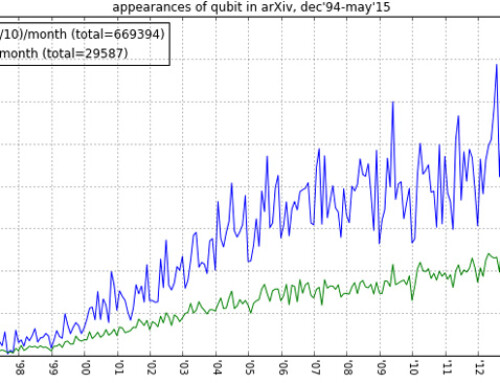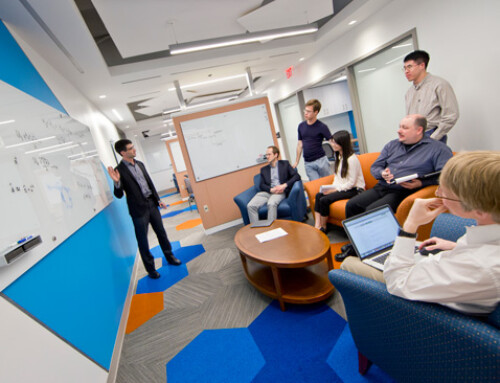A few nights ago, I attended Dr. Harvey B. Newman’s public lecture at Caltech titled:  “Physics at the Large Hadron Collider: A New Window on Matter, Spacetime and the Universe.” The weekly quantum information group meeting finished early so that we could attend the lecture (Dr. Preskill’s group meeting lasted slightly longer than two hours: record brevity during the seven months that I’ve been a member!) We weren’t alone in deciding to attend this lecture. Seating on the ground floor of Beckman Auditorium was filled, so there were at least 800 people in attendance. Judging by the age of the audience, and from a few comments that I overheard, I estimate that a majority of the audience was unaffiliated with Caltech. Anyways, Dr. Newman’s inspiring lecture reminded me how lucky I am to be a graduate student at Caltech and it also clarified misconceptions surrounding the Large Hadron Collider (LHC), and the discovery of the Higgs, in particular.
“Physics at the Large Hadron Collider: A New Window on Matter, Spacetime and the Universe.” The weekly quantum information group meeting finished early so that we could attend the lecture (Dr. Preskill’s group meeting lasted slightly longer than two hours: record brevity during the seven months that I’ve been a member!) We weren’t alone in deciding to attend this lecture. Seating on the ground floor of Beckman Auditorium was filled, so there were at least 800 people in attendance. Judging by the age of the audience, and from a few comments that I overheard, I estimate that a majority of the audience was unaffiliated with Caltech. Anyways, Dr. Newman’s inspiring lecture reminded me how lucky I am to be a graduate student at Caltech and it also clarified misconceptions surrounding the Large Hadron Collider (LHC), and the discovery of the Higgs, in particular.
Before mentioning some of the highlights of Dr. Newman’s lecture, I want to describe the atmosphere in the room leading up to the talk. A few minutes before the lecture began, I overheard a conversation between three women. It came up that one of the ladies is a Caltech physics graduate student. When I glanced over my shoulder, I recognized that the girl, Emily, is a friend of mine. She was talking to a mother and her high school-aged daughter who loves physics. It’s hard to describe the admiration that oozed from the mother’s face as she spoke with Emily–it was as if Emily provided a window into a future where her daughter’s dreams had come true. It brought back memories, from when I was in the high schooler’s position. As a scientifically-minded child growing up in Southern California, I dreamed of studying at Caltech, but it seemed like an impossible goal. I empathized with the high schooler and also with her mother, who reminded me of my own mom. Mom’s have a hopeless job: they’re genetically programmed to want the best for their children, but they oftentimes don’t have the means to make these dreams a reality. Especially when the child’s dream is to become a scientist. It’s a rare parent who understands the textbooks that an aspiring scientist consumes themselves with, and an even rarer parent, who can give their child an advantage when they enter the crapshoot that is undergraduate admissions. The angst of the conversation reminded me that I’m one of the lucky few whose childhood dreams have come true–it’s an opportunity that I don’t want to squander.
The conversation between two elderly men sitting next to me also brought back uncomfortable memories. They were trying to prove their intelligence to each other through an endless proceeding of anecdotes and physics observations. I empathized with them as well. Being at a place like Caltech is intimidating. As an outsider, you don’t have explicit credentials signaling that you belong, so you walk on eggshells, trying to prove how smart you are. I’ve seen this countless times, such as when I give tours to high schoolers, but it’s especially pronounced amongst incoming graduate students. However, it quickly fades as they become comfortable with their position. But to outsiders, every time they re-enter a hallowed place, their insecurities flood back. I know this because I was guilty of this! I spoke with the gentlemen for a while and they were incredibly nice, but smart as they were, they were momentarily insecure. Putting on my ambassador hat for a moment, if there are any ‘outsiders’ reading this blog, I want to say that I, for one, am glad that you attend events like this.
Moving on to the lecture itself, along with being a Caltech Professor, Dr. Newman has a leadership role at one of the LHC’s two general-purpose particle detectors, the Compact Muon Solenoid (CMS). The LHC uses superconducting magnets to steer bunches of protons around a 27km circular track. Each bunch contains $latex 10^{11}$ protons traveling at > 99.99999% the speed of light. Once protons are traveling at this velocity, they are steered towards collision. That’s where the detectors come in. The CMS is a wildly complex four-story-tall behemoth of a machine which delicately detects the particle by-products that result when bunches of protons collide. When these high-energy protons collide, they spew their constituent particles in all directions — it’s similar to how gears and bolts are ejected when a car is subjected to a high-speed collision. I didn’t understand how the detectors work until listening to this talk. The photo below shows a cross-sectional wedge of CMS.  The trick is that each layer uses a specific material, chosen so that different fundamental particles interact in uniquely identifiable ways as they proceed through the detector. For example, one of the first layers is composed of transparent lead tungstate crystals ($latex PbWO_4$) which scintillate (produce light in proportion to particle energy) when electrons and photons pass through. The outermost layer is occupied by muon detectors (cathode strip chambers). Muons are similar to electrons, but are 200 times heavier, and can travel through several meters of iron without interacting. Their detection is therefore left to the outermost layer. When taken in tandem, the different layers of CMS allow physicists to determine the type and energy of particles created in the LHC’s proton-proton collisions.
The trick is that each layer uses a specific material, chosen so that different fundamental particles interact in uniquely identifiable ways as they proceed through the detector. For example, one of the first layers is composed of transparent lead tungstate crystals ($latex PbWO_4$) which scintillate (produce light in proportion to particle energy) when electrons and photons pass through. The outermost layer is occupied by muon detectors (cathode strip chambers). Muons are similar to electrons, but are 200 times heavier, and can travel through several meters of iron without interacting. Their detection is therefore left to the outermost layer. When taken in tandem, the different layers of CMS allow physicists to determine the type and energy of particles created in the LHC’s proton-proton collisions.
Dr. Newman, who has traveled across the Atlantic MORE THAN 700 TIMES, made a carefully worded comment in response to the publicity that the LHC has gleaned. He stated: “we discovered a new boson. It may be the Higgs.” I found this distinction interesting given the way that the discovery has been reported in the popular press. I’m far from being an expert, but the way I interpret this is that, with a 6.9 standard deviation level of significance, the LHC has discovered a new particle, and the most likely candidate is a 126GeV boson. This means that even after taking multiple hypothesis testing into consideration, the data gathered by CMS and ATLAS tells us that random background fluctuations would only yield the signatures of a new boson with this level of significance one out of every trillion times (after collecting the same number of inverse femtobarns worth of data.) We need more data to determine the coupling of this new boson to other particles, and to thereby confirm that this is the Higgs Boson predicted by the Standard Model. By the way, there were quite a few chuckles when Dr. Newman used the unit “inverse femtobarn” — another indication that not everyone in the audience was affiliated with Caltech!
Another interesting clarification was in regards to the future of the LHC. I’ve read reporting and heard stories along the lines of: “oh, the LHC found the Higgs. Great, so now they can close up shop, right?” Dr. Newman went beyond this criticism and described some of the future directions of the LHC. His list included exotic possibilities, including a proposal to search for dark matter and supersymmetry using something called “the razor,” which was pioneered at Caltech by Maria Spiropulu, amongst other places.
Dr. Newman also highlighted the work of a few Caltech students. The Caltech component of CMS has mentored research projects for over 90 Caltech undergraduates, and obviously many graduate students. An anecdote that I found particularly amusing came when he mentioned that three of the seven 2011 student awards given by the CMS collaboration, were awarded to Caltech graduate students. During my first few months at Caltech, I sat next to one of these students, Alex Mott, on bus rides to/from Hollywood during one of Caltech’s “graduate student club nights.” These are semi-annual events where ~100 Caltech graduate students descend on Hollywood so that we can pretend we don’t work all of the time. After describing his research to me, and quickly exhausting my knowledge, he transitioned into telling me about his motorcycle adventures. Seeing my friends transition from early-stage PhD students, who are basically glorified problem-set solvers, into full-blown scientists has been a surreal experience.
I’ll leave you with Dr. Newman’s thought-provoking list of outstanding questions in particle physics and cosmology:
- Are there more Higgs particles?
- What is the nature of dark matter?
- Is Nature unified: Supersymmetry?
- Why is gravity so weak; are there extra space-time dimensions?
- Why do neutrinos and quarks oscillate?
- Why is any matter left in the universe?
- Where does the pattern of particle families and masses come from?
- What is the dark energy?



